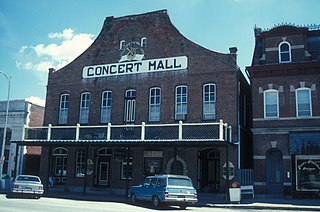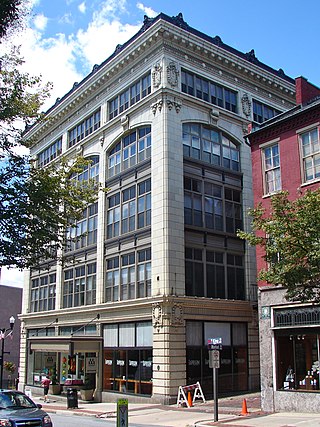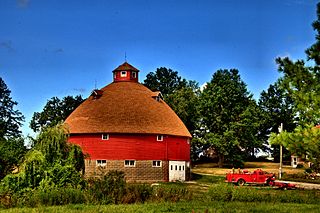
Kemper Military School & College was a private military school located in Boonville, Missouri. Founded in 1844, Kemper filed for bankruptcy and closed in 2002. The school's motto was "Nunquam Non Paratus".

Virginia University of Lynchburg (VUL) is a private historically black Christian university in Lynchburg, Virginia. The university is accredited by the Transnational Association of Christian Colleges and Schools and offers instruction and degrees, primarily in religious studies, including a Doctorate of Ministry program. The campus is a historic district listed on the National Register of Historic Places.
Boonville Correctional Center (BCC) is located at 1216 East Morgan Street in Boonville, Missouri. It is a minimum security (C-1 state penitentiary housing approximately 1,300 male inmates.

Downtown Columbia is the central business, government, and social core of Columbia, Missouri and the Columbia Metropolitan Area. Three colleges — the University of Missouri, Stephens College, and Columbia College — all border the area. Downtown Columbia is an area of approximately one square mile surrounded by the University of Missouri on the south, Stephens College to the east, and Columbia College on the north. The area serves as Columbia's financial and business district and is the topic of a large initiative to draw tourism, which includes plans to capitalize on the area's historic architecture and Bohemian characteristics. The downtown skyline is relatively low and is dominated by the 10-story Tiger Hotel, built in 1928, and the 15-story Paquin Tower.
The Walnut Street Historic District is a national historic district located in Springfield, Missouri, United States. The district encompasses more than 150 one and two story frame, brick, cast-stone, or stone dwellings in a thirteen block area. The district includes parts of East Walnut Street, East Elm Street, East McDaniel Street, Cordova Court, South Hampton Avenue, South Florence Avenue, and South National Avenue. The district developed between about 1870 and 1940, with 21 buildings surviving from before 1900, and 59 buildings dating between 1901 and 1910.

Clarksville Historic District is a national historic district located at Clarksville, Pike County, Missouri. The district encompasses 65 contributing buildings in the central business district and surrounding residential sections of Clarksville. It developed between about 1840 and 1930, and includes representative examples of Greek Revival, Italianate, and Queen Anne style architecture. Located in the district is the separately listed Clifford-Wyrick House. Other notable buildings include the City Hall (1910), Sentinel Building (1867-1871), Clifford Banking Company, La Crosse Lumber Company (1923), Presbyterian Church, Methodist Church (1906), Masonic Temple (1903), and Clarksville Public Library (1910).

Hermann Historic District is a national historic district located at Hermann, Gasconade County, Missouri. The district encompasses 360 contributing buildings, 4 contributing structures, and 3 contributing objects in the central business district and surrounding residential sections of Hermann. The district developed between about 1838 and 1910, and includes representative examples of Greek Revival and Classical Revival style architecture. Notable buildings include the Eitzen House (1855), Potnmer-Gentner House (1848), Hermann City Hall (1906), Strehly House (1845), Concert Hall (1877), The German School (1871), and Gasconade County Courthouse (1896).

William Christmas Knighton was an American architect best known for his work in Oregon. Knighton designed the Governor Hotel in Portland, Johnson Hall at the University of Oregon, and the Oregon Supreme Court Building and Deepwood Estate in Salem. He served as Oregon's first state architect from 1911–1915, appointed by Governor Oswald West. By 1915, Knighton had designed ninety building projects as state architect. In 1919, Knighton was appointed by Governor Ben Olcott as the first president of the Oregon State Board of Architectural Examiners, a position he held until 1922. In 1920, Knighton was elected the sixth president of the Oregon Chapter of the American Institute of Architects. He remained on the chapter's board of trustees for several years and was chair of the Chapter Legislative Committee into the 1930s.

Cassius Emlen Urban was a Lancaster, Pennsylvania-based architect. He was the leading architect in Lancaster from the 1890s to the 1920s.

Carson College for Orphan Girls, also known as Carson Valley School, is a historic school complex and national historic district located in Flourtown, Springfield Township, Montgomery County, Pennsylvania. The buildings remain in active use by the same institution, now coeducational and named Carson Valley Children's Aid.

Orie J. Smith Black and White Stock Farm Historic District is a historic farm and national historic district located near Kirksville, Adair County, Missouri. The district encompasses six contributing buildings and one contributing structures on a farm about three miles northeast of Kirksville. It developed between 1910 and 1919, and features a round bank barn with a self-supporting dome roof, constructed in 1913. The other contributing resources in the district are the farmhouse, an American Foursquare with Prairie School affinities (1917), a granary (1910), a poultry house (1918) and two ice houses, and a concrete bridge (1914).

Excelsior Springs Hall of Waters Commercial West Historic District is a national historic district located at Excelsior Springs, Clay County, Missouri. It encompasses 20 contributing buildings in the central business district of Excelsior Springs. The district developed between about 1894 and 1948, and includes representative examples of Victorian, Classical Revival, and Art Deco style architecture. Notable buildings include the Excelsior Springs Post Office (1914), McCleary Thornton-Minor Hospital, Montgomery Ward Building (1929), J.J. Newberry Company Building, J.C. Penney Company Building, Elks Lodge No. 1001, Washington Hotel and Orpheus Theatre, I.O.O.F. Building (1913-1917), Arlington Hotel (1899-1900), and Ideal Hotel.
Historic District A is a national historic district located at Boonville, Cooper County, Missouri. It encompasses 15 contributing buildings associated directly or indirectly with the Kemper Military School and College. The district includes the Kemper Administration Complex (1842-1904), "A" Barracks (1909), "D" Barracks (1916-1918), Johnston Field House and Pool Annex (1923-1925), Math Hall (1905-1906), Lamar Residence (1858-1860), Darby Residence (1858-1860), Dillender Residence (1895), Bertha Hitch Hall, and Kusgen-Melkersman Residence (1890-1910).

Historic District C is a national historic district located at Boonville, Cooper County, Missouri. It encompasses 63 contributing buildings in a predominantly residential section of Boonville. The district includes representative examples of Greek Revival and Queen Anne style architecture. Notable buildings include the Childers, Sr., Residence (1892-1900), Schmidt Residence (1915), Moore Residence (1880s), Holmes Property (1829-1843), Holmes Property (1829-1840), Patterson Residence (1869), Boonville Daily News Property (1910-1917), Higbee Residence (1911-1917), Knabe Rental Property (pre-1849), Catlett Property (1839), Bittner Residence (1900-1910), Putnam/Wiehe Residence (1836-1839), Cooper Residence (1860s), Travis Property (1850s-1860s), and Zoeller Property.

Historic District D is a national historic district located at Boonville, Cooper County, Missouri. It encompasses 87 contributing buildings in the central business district of Boonville. The district includes representative examples of Late Victorian and Classical Revival style architecture. Located in the district is the separately listed Lyric Theater. Other notable buildings include the Geiger's Furniture and Appliance (1870s), Missouri Power and Light Co (1900-1910), Palace Restaurant and Cocktail Lounge (mid-1800s), Boonville Music Co. (1870s), Nelson Memorial Methodist Church (1915-1917), United Missouri Bank (1914), Knights of Pythias Building (1920), First Presbyterian Church, P.N. Hirsch & Co. Department Store (1860s-1870s), Cooper County Recorder (mid-1800s), Cooper County Abstract and Insurance Co. (1910), and Cooper County Courthouse (1911-1912).
Historic District E is a national historic district located at Boonville, Cooper County, Missouri. It encompasses 88 contributing buildings in a predominantly residential section of Boonville. The district includes representative examples of Late Victorian style architecture. Notable buildings include the Dyer Residence (1870), Burns Residence, Rennison Residence (1890s), Lauer Residence (1830-1833), Robinson Residence (1905), Bell Residence (1886), Schuster Residence (1833), Kempf Residence (1890s), Cooper County Court Property, Morgan Street Baptist Church (1884), Waible Residence (1833-1848), and United Church of Christ.

Clinton Square Historic District is a national historic district located at Clinton, Henry County, Missouri. The district encompasses 62 contributing buildings, 1 contributing structure, and 1 contributing object in the central business district of Clinton. It developed between about 1885 and 1957 and includes representative examples of Italianate and Romanesque Revival style architecture. Located in the district is the separately listed Anheuser-Busch Brewing Association Building. Other notable buildings include the Fristoes Body Shop Office, Whitehead Consultants, Texas Room / Pit Stop Pub, State Farm Insurance, Montgomery Ward (1940s), J.C. Penney / Brownsbergers / Eberting's Main Street Central, Old City Hall (1891), Delozier Building (1887), Crest Cinema, Henry County Courthouse, and the Bandstand on Courthouse Square.

Courthouse Square Historic District is a national historic district located at West Plains, Howell County, Missouri. The district encompasses 46 contributing buildings in the central business district of West Plains. It developed between about 1881 and 1950 and includes representative examples of Italianate, Queen Anne, Romanesque Revival, Late Gothic Revival, and Art Deco style architecture. Located in the district are the separately listed Elledge Arcade Buildings, W. J. and Ed Smith Building, and West Plains Bank Building. Other notable buildings include the IOOF Building #2, First Presbyterian Church, Howell County Courthouse (1937), Aid Hardware Building (1914-1915), W. N. Evans Building, J. R. Foster Building, Foster-Renfrew Building, Alsup, Risley & Skillman Block, Catron Opera House / Johnson Opera House (1893), IOOF Building / J. R. Galloway Building (1896), Evans Theatre, W. J. Zorn Building, #1/Howell County Gazette Building (1911-1912), West Plains Fire Department/City Hall (1917), and Avenue Theatre (1950).
Bonnots Mill Historic District is a national historic district located at Bonnots Mill, Osage County, Missouri. It encompasses 98 contributing buildings in the central business district and surrounding residential sections of Bonnots Mill. The district developed between about 1840 and 1942, and includes representative examples of Bungalow / American Craftsman and I-house architecture. Located in the district is the separately listed Dauphine Hotel. Other notable buildings include the Bonnots Mill School (1889), Henry Dieckriede House, Bonnots Mill United Methodist Church (1915), Bank of Bonnots Mill (1907), Bonnet's Mill Hotel / Krautman's Store, Meyer-Morfeld Milling Company, United States Post Office, St. Louis Parish Church and Rectory (1907), and St. Louis Parish School.

The Sedalia Commercial Historic District is a national historic district located at Sedalia, Pettis County, Missouri. It encompasses 102 contributing buildings in the central business district of Sedalia. The district developed between about 1870 and 1959, and includes representative examples of Italianate, Romanesque Revival, and Art Deco architecture. Located in the district are the separately listed Hotel Bothwell, Building at 217 West Main Street, and Missouri/Sedalia Trust Company. Other notable buildings include the First United Methodist Church (1888-1891), Pettis County Courthouse (1924), Anheuser Busch Bottling Works, the New Lona Theater (1920), Citizens National Bank Building, Third National Bank (1929), Federal Building (1930), Montgomery Ward Building (1936), the Uptown Theatre (1936), Missouri Pacific Depot, and Central Presbyterian Church.



















